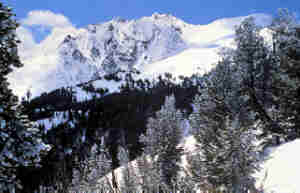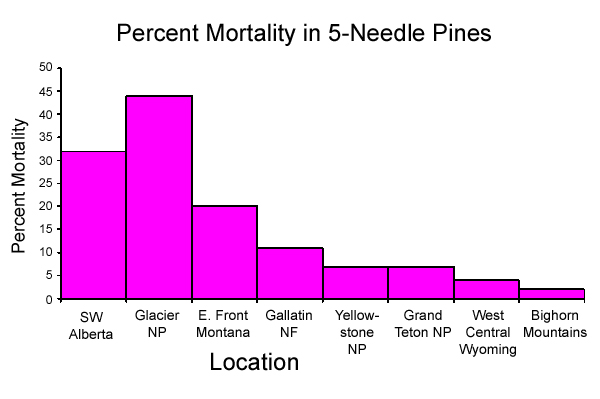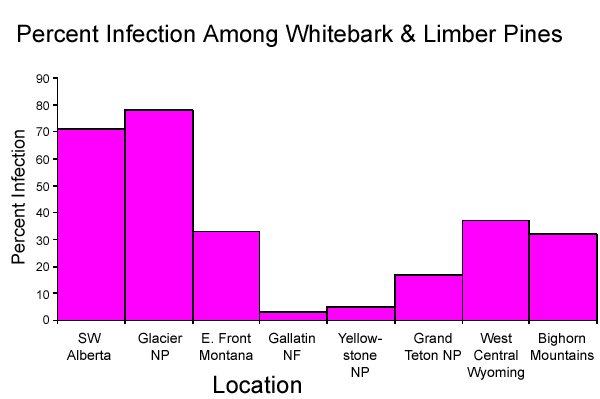Northern Rocky Mountain Science Center (NOROCK)
Home | About Us | Science | Product Library | News & Events | Staff | Students | Partners | Contact Us
Northern Rocky Mountain Science Center (NOROCK)
Home | About Us | Science | Product Library | News & Events | Staff | Students | Partners | Contact Us
 Whitebark Pine and Wildlife: With large seeds high in fats, whitebark pine trees are an important source of food for many animal species. Red squirrels and Clark's nutcrackers usually harvest the lion's share of whitebark pine seeds. Grizzly bears and black bears raid squirrel caches that contain whitebark cones to get pine seeds, one of their favorite foods. Other mammals, large and small, and many species of birds also feed on whitebark pine seeds, or pine nuts, as they commonly are called. Because whitebark pine are long-lived and can grow large trunks, they provide valuable cavities for nesting squirrels, northern flickers and mountain bluebirds.
Whitebark Pine and Wildlife: With large seeds high in fats, whitebark pine trees are an important source of food for many animal species. Red squirrels and Clark's nutcrackers usually harvest the lion's share of whitebark pine seeds. Grizzly bears and black bears raid squirrel caches that contain whitebark cones to get pine seeds, one of their favorite foods. Other mammals, large and small, and many species of birds also feed on whitebark pine seeds, or pine nuts, as they commonly are called. Because whitebark pine are long-lived and can grow large trunks, they provide valuable cavities for nesting squirrels, northern flickers and mountain bluebirds.
 Grizzly bears and black bears eat whitebark pine seeds whenever they are available. In average cone crop years, bears feed on them from mid-August to late fall. Following years of bumper cone crops, many cones remain in squirrel caches the next spring. When this happens, bears begin to feed on pine nuts as soon as they emerge from their winter dens. They are capable of locating and excavating cone caches under at least 6 feet of snow. Bears continue to feed on whitebark pine seeds as long as they are available and pine seeds from the previous year's crop can dominate bear diets for the entire next season. Research demonstrating the importance of red squirrels and whitebark pine seeds to bears in the greater Yellowstone ecosystem (GYE) and documenting the critical role of over-wintered nut caches to bear behavior and nutrition is reported in Kendall (1983) and Kendall and Arno (1990).
Grizzly bears and black bears eat whitebark pine seeds whenever they are available. In average cone crop years, bears feed on them from mid-August to late fall. Following years of bumper cone crops, many cones remain in squirrel caches the next spring. When this happens, bears begin to feed on pine nuts as soon as they emerge from their winter dens. They are capable of locating and excavating cone caches under at least 6 feet of snow. Bears continue to feed on whitebark pine seeds as long as they are available and pine seeds from the previous year's crop can dominate bear diets for the entire next season. Research demonstrating the importance of red squirrels and whitebark pine seeds to bears in the greater Yellowstone ecosystem (GYE) and documenting the critical role of over-wintered nut caches to bear behavior and nutrition is reported in Kendall (1983) and Kendall and Arno (1990).
 In addition to its importance as a wildlife resource, whitebark pine trees play other pivotal roles in the ecosystems where they occur. Because whitebark pine can grow in dry, windy, and cold sites where no other trees can establish, it pioneers many harsh subalpine and alpine sites and commonly dominates treeline communities in the northern Rocky Mountains. Its presence can modify the microclimate in alpine ecotone communities enough to allow other trees to establish, such as subalpine fir. Whitebark pine communities also influence the hydrology of the drainages where they occur. Because they grow on windy ridges and in other mountainous areas and have broad crowns, whitebark pine trees tend to act as snow fences and are responsible for significant amounts of high-elevation snow accumulation. This results in delayed snow melt and extends ephemeral stream flow periods. The ecology of whitebark pine communities is discussed in Kendall and Hoff (1995) and Kendall (1996).
In addition to its importance as a wildlife resource, whitebark pine trees play other pivotal roles in the ecosystems where they occur. Because whitebark pine can grow in dry, windy, and cold sites where no other trees can establish, it pioneers many harsh subalpine and alpine sites and commonly dominates treeline communities in the northern Rocky Mountains. Its presence can modify the microclimate in alpine ecotone communities enough to allow other trees to establish, such as subalpine fir. Whitebark pine communities also influence the hydrology of the drainages where they occur. Because they grow on windy ridges and in other mountainous areas and have broad crowns, whitebark pine trees tend to act as snow fences and are responsible for significant amounts of high-elevation snow accumulation. This results in delayed snow melt and extends ephemeral stream flow periods. The ecology of whitebark pine communities is discussed in Kendall and Hoff (1995) and Kendall (1996).
Decline of Whitebark Pine Communities in the United States and Canada: In 1995, a three-year project was begun to document the current status of whitebark pine in national parks in the Rocky Mountains from Wyoming to Alberta and to determine the historical distribution of whitebark pine in Glacier National Park, Montana. During the 1995 and 1996 field seasons, detailed information on tree status and the effect of damaging agents in 316 whitebark pine stands was collected. Field work in 1997 will focus on validating the maps created by this project of current and historical whitebark pine distribution in Glacier National Park and on report preparation.
In general, whitebark pine trees in Waterton Lakes National Park, Alberta, and Glacier National Park and Blackfoot Reservation, Montana have suffered serious declines, while further south, whitebark pine mortality was low and blister rust infection rates were moderate to low (Table 1). In the northern portion of the sample area, approximately 30% of the whitebark pine trees were dead, and of the remaining live trees, about 70% were infected with rust and had an average of 25% crown kill. In the Greater Yellowstone Ecosystem, whitebark mortality averaged 7%. Blister rust infection of whitebark pine occurs throughout the area, mostly at low levels (<5%). Infection rates in some areas were considerably higher. In Grand Teton National Park, for example, blister rust incidence averaged 10% but infection rates in several sites ranged from 40-44%. The moister climate of the Tetons compared with Yellowstone National Park is probably responsible for the higher rust levels.
Table 1. Preliminary data on the status of and effect of blister rust on whitebark pine (Pinus albicalus) stands sampled in 1995–96.
| Area sampled | Number of sample sites | Mean Mortality %1 (range) |
Mean Definite infection % (range) |
Mean Probable infection %2 (range) |
Mean crown kill %3 (range) |
| Blackfoot Reservation, MT | 5 | 61
(45-85) |
84
(65-100) |
85 (69-100) |
30
(18-52) |
| Central Idaho | 1 | 1
- |
3
- |
5
- |
0
- |
| Glacier National Park, MT | 174 | 45
(0-100) |
73
(0-100) |
79
(0-100) |
29
(0-70) |
| Grand Teton National Park, WY | 34 | 7
(0-50) |
10
(0-44) |
15
(0-62) |
1
(0-9) |
| Waterton L. National Park, Alberta | 8 | 26
(14-48) |
44
(14-59) |
47
(14-62) |
13
(3-18) |
| Yellowstone National Park, WY, MT, ID | 95 | 7
(0-64) |
4
(0-58) |
5
(0-58) |
1
(0-21) |
1 Includes mortality from all causes.
2 Includes trees which were probably, as well as,
definitely infected with blister rust.3 Average crown kill of all live whitebark pine trees.
Cause of Whitebark Pine Declines: Field research on northern Rocky Mountain ecosystems demonstrated that whitebark pine is functionally extinct in more than a third of its range. In the Greater Glacier Ecosystem in NW Montana and SW Alberta, dramatic declines are primarily attributable to a disease, white pine blister rust, and fire exclusion. Blister rust is an exotic fungus accidentally introduced from Europe to western North America around 1910. A massive effort to control blister rust was unsuccessfully waged from 1930-1970. White pine blister rust has severely damaged cone production capability and whitebark pine regeneration is currently limited by seed availability.
Blister rust is making significant in-roads in the Greater Yellowstone Ecosystem and serious declines can be expected in coming decades. Information on status and trends inwhitebark pine communities that span millions of acres and constitute critical food for one of the most viable grizzly bear populations in the lower 48 states is reported in Kendall (1997), Kendall et al. (1996a,b), Kendall (1995), and Kendall and Arno (1990). Whitebark pine conservation needs and whitebark pine management policy issues in national parks and wilderness are discussed in Kendall (1994) and Kendall and Schirokauer (1997).



Katherine Kendall katherine_kendall@usgs.gov
USGS-BRD
USGS Building, c/o Glacier National Park
West Glacier, Montana 59936-0128
Tomback, D. F. and K. C. Kendall. Biodiversity losses: the downward spiral. Tomback, D.F., Stephen F. Arno, and Robert E. Keane, editors. Island Press, Washington, DC. 2001. pg. 243-262.
Kendall, K. C. and R. E. Keane. Whitebark pine decline: Infection, mortality, and population trends. Tomback, D.F., Stephen F. Arno, and Robert E. Keane, editors. Island Press, Washington, DC. 2001. pg. 221-242.
Kendall, K. C. Whitebark pine ecosystems: Status and trends. In: Walker, R. and R. Kubian, editors. Parks Canada, Radium Hot Springs, B.C. 1996. Vol. 4. pg. 88-98.
Kendall, K. C. and S. A. Arno. Whitebark pine -- An important but endangered wildlife resource. Proceedings of the Whitebark Pine Symposium, USDA Forest Service General Tech. Rep. INT-270. 1990. pg. 264-273.
KEYWORDS
- black bear ecology, grizzly bear ecology, Pinus albicaulis, population trends, whitebark pine communities
- GEOGRAPHIC DISTRIBUTION
- Alberta and British Columbia, Canada, Glacier National Park, MT, Grand Teton National Park, Montana, Waterton Lakes National Park,Wyoming, Yellowstone National Park
OTHER LINKS
Visit NUTCRACKER NOTES
for more information on whitebark pine ecosystems
Content Information Contact: kkendall@usgs.gov